QUICK START GUIDE

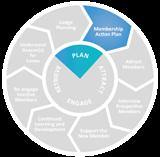
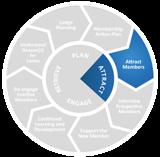
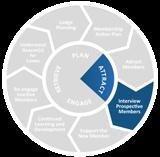
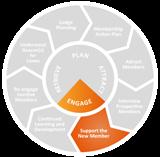


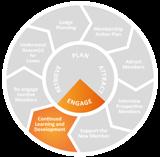









When faced with a document outlining the Strategy for the coming years, at the Lodge level, there is always a dangerof regarding it as something of relevance only to UGLE – “nothing to concern ordinary Lodge members”. Actually, the opposite is true, since the Strategy will only succeed with the full involvement of all members.
This means we all need to have a clear and shared understanding of the direction we are going, ensuring actions can contribute over time to a stronger, more secure future for our Lodges.
We must now focus our energy on
• attracting new members (not necessarily young!)
• making sure that both new and established members find Freemasonry { c FUN & enjoyable
{ c satisfying and encouraging them to remain members for life.
This way, we will reverse the decline in numbers of recent years (which some Provinces, with the help of The Members’ Pathway, are already achieving), but we first need to understand why we have been losing more members than we have been gaining.
We can’t do much about ill health and deaths, but many resignations (especially those lost when members move or Lodges close) and even cessations and exclusions are potentially avoidable. We need to be alert to the early signs of poor attendance or late payment of dues and step in to offer support and encouragement as appropriate.
Of particular concern is the number of new members who leave within three years of joining, and we need to ask what we have done or not done which has led to these early resignations. At the same time we must be pro-active in attracting new members to Freemasonry. The recent National Digital Marketing Campaigns have shown that there are significant numbers of people who are interested in joining - our task is to create the opportunities at local level for those potential members to acquire an insight into Freemasonry.
The overarching aim of the Strategy for the next seven years is to attract more members and grow Lodges, which, not just by chance, is the sub-heading of The Members’ Pathway. The Members’ Pathway offers guidance and suggestions in numerous areas of Lodge practice directly relevant to key parts of the Strategy.
• planning to strengthen your Lodge and attract new members (not just young members)
• screening potential members to make sure they are a good fit for both Freemasonry in general and your lodge in particular
• finding ways to involve every member in the life of the Lodge through formal or informal roles and contributions suited to them, to increase their sense of belonging, interest and commitment
• being ready to step in where members are having difficulty or just drifting away, or have even resigned
However, even with the reassurance of all the help and support which is available in the Members’ Pathway, that alone will not achieve the desired results.
We need to take a long hard look at how we run our Lodges and be prepared to make changes where necessary - to try something new - maybe something you have experienced in another Lodge - or to stop doing something if it isn’t working for your Lodge.
We are rightly proud of our Lodge traditions, but as the years pass, some become outdated, or unhelpful.
Henry Ford reminded us that if you always do what you always did, you will always get what you always got.
Take up the mantra of YES IF instead of No Because….
• encourage innovation
• embrace change and share successful ideas
• identify and use members’ skills and talents, whatever their rank
• reach out to local communities to demonstrate our unique combination of fun/sociability and serious and timeless core values
• be ambassadors for Freemasonry
In this way you will be helping to secure the future of your Lodge and the success of the seven year strategy for our remarkable organisation.
In recent years Freemasonry has unfortunately been losing more members than it has been gaining and The Membership Challenge, which every Lodge is asked to address, is essentially to reverse that trend. It is an intrinsic part of the Strategy for 2022 and beyond.
Although you might see figures referring to the size of the Challenge at UGLE level, or Provincial level, it is your individual Lodge figures which are the most relevant to define what actions will be needed at Lodge level.
Your Lodge records or even Provincial records can provide the membership statistics for the previous 5+ years which will show how many members have been lost and how many new members have joined – whether the trend is positive or negative.
When considering how to close the gap between gains and losses, the most reasonable and practical approach would be to increase the gains and at the same time reduce the losses.
This will require determined effort over time, involving all Lodge members, arranging events to attract new members, finding ways to involve every member in the life of the Lodge to increase their sense of belonging, interest and commitment, and being alert to the early signs of poor attendance or late payment of dues, ready to step in to offer support and encouragement as appropriate.
The Members’ Pathway provides an overall framework to help Lodges to:
• Plan Lodge and Membership Development
• Attract and welcome new members
• Engage with new and existing members to increase involvement and satisfaction and minimise losses due to resignation, cessation and exclusion.
• Find ways to encourage those who have drifted away to re-kindle their interest and re-join.
The aim is to help Lodges be more vibrant and meetings more enjoyable and satisfying, so that every member looks forward to the next meeting with an infectious enthusiasm.
The Members’ Pathway documentation is designed to be accessed online. This Quick Start Guide is available as an interactive PDF and as this A5 Landscape (limited run) printed version available from your Provincial / Metropolitan support teams.
The overall structure of the Members’ Pathway is described in the rest of this booklet.
The Members’ Pathway contains practical ideas drawn from the experience and successes of Lodges over recent years in engaging members, ensuring meetings are well planned and enjoyed by all, stemming losses and growing memberships.
It should be the catalyst to help re-build our Lodges and re-engage our membership capitalising on the great PR Freemasonry has received because of the incredible community support provided, for example, during the Covid crisis.
It will allow us to showcase all that is great about Freemasonry, demonstrating how we champion our values of Integrity, Respect, Friendship and Charity.
It will also help to answer questions such as:
• Who might be interested in Freemasonry?
• How do we present Freemasonry to prospective members?
• How do we support new and existing members?
• How do we make meetings enjoyable and appealing, so that expectations are met and members get involved?
Using the Members’ Pathway successfully relies on the Lodge Membership Team (Membership Officer, Mentor, Almoner, amongst others) and the support Lodge Members give them.
All Lodges are encouraged to find someone to take on each role, even if, due to availability, it has to be combined with another.
Every member of the Lodge, from the newest to the most experienced, should have the opportunity to contribute to Lodge and Membership Development. A willingness to embrace change as part of inspiring and motivating Lodge Members will be a pre-requisite for success.
The Members’ Pathway recognises individual Provinces and Lodges have created different structures to support members at various stages of their journey; it is flexible and not prescriptive.
The Provincial Members’ Pathway Teams are also available to guide and support Lodges.
The updated Members’ Pathway has been developed to direct the Brother with ease to the support materials he needs.
It is presented as a circle illustrating the continuing cycle of review, plan and do, that evolving and improving Lodges go through.

The aim is to help create stronger, more vibrant Lodges, with happy members who demonstrably enjoy their Freemasonry.
The Hub is the starting point when using the updated Members’ Pathway, the four sections of the hub are shown here.
Hub sections expand to Elements, here major topics (as headlines) are introduced which relate to areas of Lodge activity.

STARTS WITH:
• Lodge & Membership Planning
Finally extending from the Elements are the Threads. The twenty-six threads break down the Elements (headlines) into subtopics. The updated Members’ Pathway has been designed so the content of the Threads is available online, through the b.ugle.org.uk/membership website.
ENDS WITH:
A repeatable cycle to sustain the Lodge and its Members

PROGRESSES THROUGH:
• Attracting new Members
This booklet has a short summary of each Thread. These are presented visually working clockwise. Remember work from HUB > ELEMENT > THREAD to find the materials you want.
This document is available as both a printed booklet and as an interactive PDF. The PDF version includes links to detailed web-based guidance, linking between resources to help you navigate between the threads.
• Engaging interest in freemasonry and involvement in Lodge Activities
• Involving all Members
• Helping Members to find new Lodges
• Supporting a Member through his early journey in freemasonry
PLAN Lodge Planning
What are we?
1
Description of the Lodge (location, meetings, dates etc)
Cost of membership (annual dues, dining and joining fees)
PLAN Lodge Planning
Understand your Lodge
The first stage in any plan is a review of the current situation, to identify issues that need attention which should be built into a plan. This applies to Lodges as much as anything else.


‘Understanding your Lodge’ describes how a Lodge can take stock and review its current situation, consider whether it is attractive to likely members and lay the foundation for a plan for its future. We recommend that every Lodge return to this process at regular intervals, whether it is a successful Lodge or a Lodge that is struggling.
Once a Lodge Outline has been developed, you are able to start considering the Lodge’s strengths, weaknesses, opportunities and threats. List everything relevant to each area and then look to agree specific actions to enhance/promote the strengths and opportunities, reduce or remove the weaknesses and threats.
OPPORTUNITIES THREATS
What are we? captures the results of a Lodge review in a Lodge Outline. A Lodge Outline is an honest self-assessment of your Lodge at a particular point in time. It describes the Lodge’s key features and especially its characteristics, circumstances, expectations and values. It should answer all the questions a person interested in membership might ask.
It is not intended to act as a Lodge brochure or any other form of promotional material. It is written for Lodge members, an internal audience, using the language of Freemasonry. However, it is the basis for developing all promotional materials, such as a Lodge Information Sheet, aimed at those who are not Freemasons. These are described in further threads.
2
Health of the Lodge
3
How would the Lodge describe itself in terms of… ritual, tradition, social, charity, support of new members, etc?
4
A Lodge Outline template is available within the Members’ Pathway documents, but please speak with your Metropolitan, Provincial or District Grand Lodge Membership Team first as they may have a document that is preferred.
Lodge’s expectations of members
5
Why should a man join the Lodge?
(what are you offering?)
6 Lodge culture (hierarchy, communication etc)
7
8
What’s important to the members? (ritual, tradition, social, festive board, etc)
9
10
What’s important to a new or joining member?
Does the Lodge meet the needs of a new or joining member?
A succession plan is used to plan for the rotation and succession of available people into key roles. In a Lodge it is used to identify members who are interested in certain offices and to ensure that the Lodge does not become over dependent on a few members.
This thread includes guidance for building your Lodge succession plan and a template for doing so.
It is as important to plan the succession through both progressive and non-progressive offices as it is to plan ceremonies. This allows for preparation and training of new Officers, so that there is a smooth transition and handover to Brethren taking on new roles, and also highlights where members are potentially in a role for too long.
A simple spreadsheet can be created that identifies all of the Offices within the Lodge and planned ceremonies for the forthcoming year and beyond, which will enable each Officer to be able to plan ahead (rather than, as all too often happens, trying to sort out Officers on the night).
This concept can also be applied to any Lodge of Instruction (LOI) where relevant.
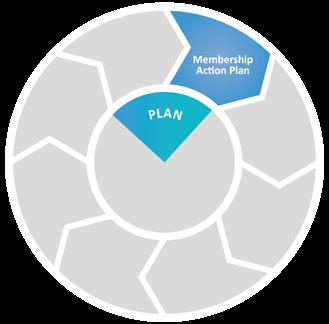

The Lodge Membership Team should work with Brethren to ensure members are provided with sufficient information so they can confidently respond to any prospective candidate’s questions regarding Freemasonry in general and their Lodge in particular.
Reviewing the threads in Lodge Planning will give you the information which you can use to put this message together. Remember basic detail such as costs, dress code, location and frequency of meetings are all details which often are a given for long standing members but for a prospective member this is essential information that will be key to them making a decision on joining.
The UGLE Communications and Marketing Team have been working with Metropolitan and Provincial Communications teams to develop answers to a range of questions regarding becoming and staying a Freemason. Additional information can be found online at the updated Members ‘Pathway under the ‘Membership Action Plan’ element.
Being proud to be a Member
Where new Members come from


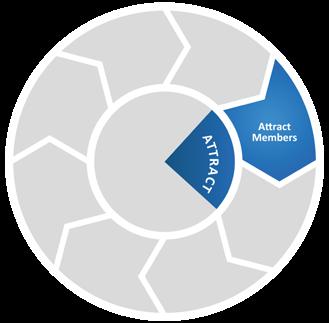
Lodge
If you are likely to be discussing Freemasonry with people who are not Freemasons, it is important to be in a positive frame of mind, proud of your membership, honest and clear about what Freemasonry means to you. It helps to consider these issues in advance, to clarify your own thinking about the subject.
Being proud to be a member will help you prepare and address questions such as, “What is Freemasonry?” or “Why are you a Freemason?”
The traditional route for new members to join a Lodge is through long standing friends, family members and colleagues. The personal recommendation of a candidate by an existing member is recognised and respected by the other brethren.
Candidates who come through this route are often referred to as sponsored candidates.
The growth of the internet and social media, coupled with UGLE’s increased openness, have introduced other routes into membership for people attracted to what Freemasonry can offer but who do not know a Freemason themselves (often referred to as an unsponsored candidates). UGLE and its Provinces now run a sophisticated system to receive, screen and allocate enquirers to Lodges that are best suited to them.
The future health and strength of your Lodge will benefit from you understanding the balance between these two routes and why and how people to join a membership organisation.
Freemasonry is more open now than it ever has been. Social media platforms have become an increasingly popular channel for communication in the 21st century. They provide ways to share content with a wide audience and as such, are excellent tools for sharing information about Freemasonry and masonic activities.
As well as allowing Freemasons to communicate with each other, social media platforms also make it easy to engage non-masons. Social media platforms are therefore excellent for increasing awareness and attracting potential new members, as shared content will be available to anyone searching using masonic keywords. That is to say, someone who is connected to a Freemason on social media may see something masonic they have shared, which may prompt them to learn more about Freemasonry and perhaps enquire about membership.
Guides on the use of social media and websites can be found through your Membership Team or on the bUGLE website
b.ugle.org.uk/communications


Lodges with a strong social element and which are engaged in and have visibility in supporting community-based events and projects are generally more successful at attracting new members.
Each of us knows a large number of people from various facets of our lives, including family, friends, work colleagues, members of other organisations we belong to. Many may have some curiosity about Freemasonry and creating an opportunity for them and their wives and partners to meet us socially is a fantastic opportunity for us to introduce them in a low-key way to who and what we are – and may lead to them wishing to join.
Lodges engaging in community/charity events have an incredible opportunity to promote what Freemasonry stands for, while also raising awareness of the local Lodge and its members.
Freemasonry means many different things to each of us, but there is a common thread through our key values of Integrity, Friendship, Respect and Charity.
When explaining what Freemasonry means to you, it is helpful to use your own words and not overcomplicate it with the vocabulary used in Lodge.
Your thoughts should be personal to you in answering any questions. Be honest, anticipate the difficult questions and be in a position to respond to them positively and without being defensive, using everyday language.
There are numerous leaflets and online documents that you can provide to the inquiring individual.
If you need help explaining what it means, look at the UGLE website or your Metropolitan, Provincial or District Grand Lodge website.
An essential part of the membership process is matching potential candidates to a suitable Lodge.
Every Lodge has different characteristics and it is crucial for a Lodge to understand what they represent, what they find important and what they want to achieve for the future so that they can match the potential candidate’s expectations with what the Lodge has to offer. While it may go against the grain, it is better to find a more appropriate other Lodge than to draw in a potential member and risk losing him because their expectations cannot, for whatever reason, be met.
An easy way to understand this is to create a Lodge Information Sheet. This could even take the form of a promotional leaflet and be used by the members when interacting with potential new members and explaining more about the Lodge.
In summary, the Lodge Outline is an honest self-assessment of the Lodge intended for internal use. The Lodge Information Sheet is based on the Lodge Outline but is written for those who are not Freemasons, in everyday language, and is used to promote and explain the details of your Lodge.
Please liaise with your Membership Team as they may well have a preferred template for such information or be able to give you guidance.
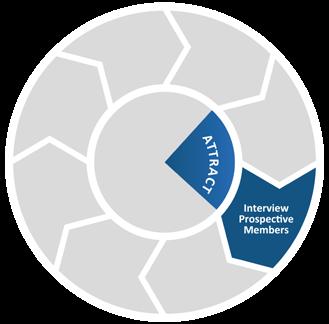

Sponsored candidates are those already known to a Lodge member (the traditional route); unsponsored candidates are those who generally enquire through social media or websites, etc.
What is essential for both is that a Lodge has a process in place on how to manage the enquiry.
Metropolitan, Provincial and District Grand Lodge Membership Teams will have a process in place for unsponsored candidates prior to introduction to a suitable Lodge.
Good practice suggests:
Set up a Lodge Membership Team (a couple of members)
Meet the candidate at a neutral venue
Discuss expectations –both their’s and the Lodge’s Additional meetings –gather more information/ get to know them
Introduction to Lodge members – after the LOI or at a social event (including online events)
Invite them to social events –ladies’ night etc
Discuss the timeline regarding becoming a member Discuss cost and fees (a chance to use your Lodge Information Sheet).
It is recommended that the interview is conducted by three Lodge members to create a positive experience for the applicant. Ideally, at least one of the interviewers should know the candidate or have met him during the Enquiry Management phase, and is therefore seen as a friendly face.
• Informal meetings
• Be open, honest, clear and direct about the commitment involved in becoming a Freemason
• Answer any questions and if you don’t know the answers say so, find out and go back to the applicant
• Explain the process – interview, proposal, ballot, initiation and potential timescales


• Set date for interview.
INTERVIEW:
• No more than three to four members of the Lodge to deliver a friendly environment
• Structured process
• Use example questions with skill and discretion
• Communicate the outcome in a timely manner.
If enquiry management and preparation for the interview have been conducted properly, the actual interview should not hold any surprises.
The candidate will form a lasting impression of Freemasonry based on his early experiences (both positive and negative!) and the expectations of the candidate and those of the Lodge members need to be carefully managed and aligned.
The preparation for the initiation should not be a rushed process as there is a balance between the needs of the candidate and the Lodge’s programme of work.
When briefing the candidate for his initiation, strike a balance between telling him enough so that he is prepared and not telling him too much, which can spoil the occasion.
Consider the following for the candidate:
Arrange a lift to and from the meeting
Introductions – WM, JD and Tyler
Ensure he has a bottle of water as he waits for the ceremony
Introduce him to members after the meeting
Explain the toasts
Maintain contact after the meeting
Introduce to LOI
Sit him with a member after the ceremony
Have some cash for him for charity collections etc
Ensure someone hosts him at his first full meeting and explains what is happening.
From his first meeting, the new Freemason is presented with a huge amount of information. He will want to make sense of this and learn at his own pace and in his own way about the organisation he has joined. While a lot of written and video material is available to him, it is important that he can be guided through it by a Personal Mentor who understands his interests and the priorities of his Lodge.
Liaise with your Membership Team regarding the use and availability of any such materials and ensure the materials are not just ‘dumped on’ the new member but are explained. Don’t overwhelm him with too much information.
Signpost the new mason to the Solomon resource and demonstrate how to navigate the site and get the most from it.
Lodges that conduct good ceremonial and ritual, have vibrant festive boards and have a social element outside of Lodge meetings tend to be the most successful Lodges regarding membership.
Participation can be split into three areas:
LODGE MEETING ATTENDANCE:
• Ensure he knows the dates
• Discuss timing of attendance before the meeting
• Meet him well ahead of any meetings to run through any signs, movements etc
• Discuss his progression within the Lodge
• Explain the protocol of visiting and inviting
• Take him to see an initiation at another Lodge
• Encourage him to invite masonic guests to meetings.
LODGE
• Encourage his attendance
• Explain that he can invite friends, family etc (if applicable)
• Get him involved in the events.
LOI is an important part of the Understanding process as it is generally a more relaxed environment for questions to be asked.
The Understanding (Thread) links closely with Stewardship (Thread) of Support the New Member (Element) of ENGAGE (Hub).
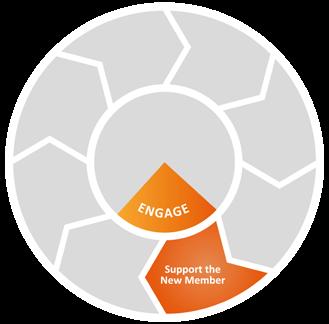

• Encourage him to deliver pieces of ritual
• Designate someone to accompany him out of the Lodge if he has to retire for any reason.
Metropolitan, Provincial and District Grand Lodges also have many special interest Lodges and numerous different clubs that will enhance a members’ enjoyment of his Freemasonry. Liaise with your Membership Team to find out more.
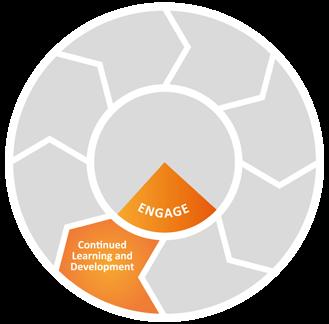

The new mason has just entered a new world and requires assistance to guide him while he takes the initial steps on his masonic journey. This can be achieved by appointing a member of the Lodge to take on this responsibility acting as their Personal Mentor. Thought also needs to be given as to who is best suited to undertake this important role.
Freemasonry should be fun and exciting, especially to new and younger masons. Members who are happy with their Lodge and who are comfortable and satisfied as Freemasons will attract visitors and new members.
New & Young Masons’ Clubs are a fantastic addition to a new member’s Freemasonry experience. In addition Metropolitan, Provincial and District Grand Lodges have many various clubs and special interest Lodges that may interest the new mason.
Any new member may need some assistance and encouragement to look beyond activities taking place at the lodge level. Social media, websites and internal communications are important avenues to be explored by new members.
Learning about Freemasonry, developing an understanding of it and taking part is central to our enjoyment of it. New members in particular have a need for new learning and these needs fall into two parts.
The first is what Freemasonry wants or expects them to learn, so that they can participate. The second is what they wish to learn about Freemasonry, to satisfy their own interests and motives for joining.
Experienced members also find that at different times in their membership they need to learn new things, especially as they approach the chair, become a Past Master, take on continuing office in a Lodge and, perhaps, become Metropolitan / Provincial / District or Grand Officers.
The Thread gives guidance for Lodges, to help them guide a new and existing member’s learning in those aspects that Freemasonry wants or expects them to learn.
GUIDANCE ON LODGE PROTOCOL:
• How to wear an apron correctly
• How to give the signs, tokens and words
• Addressing members of the Lodge and guests
• Fire at the festive board
• Visiting.
PREPARATION FOR PASSING AND RAISING:
• Questions and answers, support and practice
• Correct regalia and options for purchase.
LODGE PROCEEDINGS:
• Sit with him
• Explain process
• Voting/balloting.
UNDERTAKING RITUAL:
• Discuss with him – no pressure!
• Provide positive encouragement
• Time to practise.


It is important to discuss with the new and junior member how he would prefer to access information with regards to learning.
LEARNING CAN BE UNDERTAKEN BY:
• Personal research
• Supplied reading
• Books
• Websites
• Discussion
• Online resources – UGLE webinars, Solomon Live, etc.
The Solomon online resource is a superb repository for learning and new members should be encouraged to register. The LOI should also be considered the foundation for any learning that the new member undertakes. What is most important is that new and junior members are allowed to set the pace of any development so that it remains an enjoyable part of their discovery of Freemasonry.

The English Constitution is unique in the fact that the Royal Arch is considered an integral part of our Masonic experience. An indissoluble link exists between Craft Freemasonry and the Royal Arch. Together they constitute ‘Pure Antient Masonry’ as stated in the Preliminary Declaration of the Book of Constitutions:
“By the solemn Act of Union between the two Grand Lodges of Free-Masons of England in December 1813, it was ‘declared and pronounced that pure Antient Masonry consists of three degrees and no more, viz., those of the Entered Apprentice, the Fellow Craft, and the Master Mason, including the Supreme Order of the Holy Royal Arch’.”
Formal introduction can take place when the Master Mason is presented with his Grand Lodge Certificate. The Province’s introductory leaflet to the Royal Arch can also be presented, and often new Master Masons receive a joint letter from the Provincial Grand Master and Grand Superintendent. However, it is expected that the four stage masonic journey and the role of the Royal Arch in the completion of that journey will have been clearly explained to all Lodge members long before this point. Indeed, a series of papers that can be given in a Craft Lodge to begin to introduce the Royal Arch to Craft masons are available in Solomon.
In many Lodges a Royal Arch Representative (or similarly named officer) acts as the link between the Royal Arch and the Craft. Their role is to promote the Royal Arch amongst Lodge members and they should be suitably qualified for that purpose.
• Build on the lessons learned in the Craft
• Experience a beautiful, inspirational story
• Meet Brothers as Companions AND enjoy completing your journey to unlock the secrets of Pure Antient Masonry
The decision and timing must always be the candidate’s and no undue pressure should applied.
This document is intended only as basic guide. More comprehensive information on introducing the Royal Arch for Lodges and Chapters as well as bespoke guidance for Royal Arch Representatives will be forthcoming via ‘Archway: a resource for Royal Arch Chapters and Provinces.’
‘Discover Freemasonry in the Craft: Discover More in the Royal Arch’
Managing migration
Migration is the process of assisting members find a new Lodge when they relocate across Provincial boundaries or abroad. Its purpose is to help members find new Lodges well suited to them and to enable them to continue their membership without a break in service.
Achieving this purpose involves two elements.
First, an agreed system or processes operated by Officers in the Lodge and beyond and, secondly, awareness in Lodges of members planning to relocate. This awareness enables the migration system to be triggered at an early point and membership continued without a break.
There is an agreed process between Provinces and operated by a designated Provincial Migration Officer. The current process is described in the document Migration flow chart.


Tracking attendance & apologies
A resignation is often preceded by periods of absence, relative to the individual’s normal pattern of attendance. Therefore, a break in pattern and reduced attendance is a warning sign of possible issues, whether they relate to reduced interest, dissatisfaction or a change of personal circumstances. It makes sense for Lodges to monitor individual attendance, and to make enquiries if absences vary or increase from their normal pattern.
Dis-engagement is usually a consequence of lack of involvement and can come at any stage in a Brother’s membership – the Master Mason who doesn’t want to progress through to the Chair (and isn’t good at ritual,) the Past Master who feels the anti-climax after years working through to Worshipful Master, the senior member who has nothing to do.
While some members are quite happy being ‘left alone’, with others the above situations often progress to poor attendance and eventually to resignation.
Re-engagement should be attempted as soon as signs are evident, but an observant Mentor or Almoner may be pro-active in approaching a Brother with suggestions to involve him the Lodge’s activities.

All members should be made aware of the warning signs that may lead to a potential loss through resignation, cessation or exclusion.
Understand Reason(s) for Losses
Unattached Freemasons
A reduction in the pattern of attendance or participation is a key indicator of someone losing interest, drifting away and a potential resignation.
• Lodge secretaries should maintain an attendance register for each meeting and when a Lodge member misses two consecutive meetings, the Lodge Almoner should contact the members to find out if there are any problems.
• Regular contact with non-attending members should be routine, no matter how many meetings are missed or whether apologies are registered; quite often there are undisclosed reasons for non-attendance.
• Actions should be taken to address the reasons for non-attendance so all members can remain active members of the Lodge.
WARNING SIGNS:
• Changes in personal circumstances
• Unwillingness to take office
• Lack of preparation before the meeting
• Not turning up at the last minute
• Delays in paying Lodge dues
• Not responding to calls and communications.
Being ‘unattached’ literally means not currently belonging to any Lodge. This may be the result of Lodge closure, change in job or personal circumstances which make attendance at meetings difficult or relocation to a different area.
Re-engaging with these Brethren can often lead to their consideration of re-joining Freemasonry, particularly if their personal circumstances have improved.
EARLY ACTION:
• Identify the best person within the Lodge to make contact
• Identify the needs, concerns and expectations of the member
• Engage with Metropolitan, Provincial or District Office for assistance
• Utilise 60-day cooling-off period to make contact and address issues prior to resignation being confirmed
• Offer of support – financial, welfare, etc
• Discuss all options open to the member.
The process of re-engagement is often best achieved in conjunction with a Provincial or Metropolitan Team tasked with retrieval, rather than relying solely on contact with a potential recipient Lodge.
Further information can be found in the online support materials and working with your Provincial / Metropolitan Members’ Pathway Team.
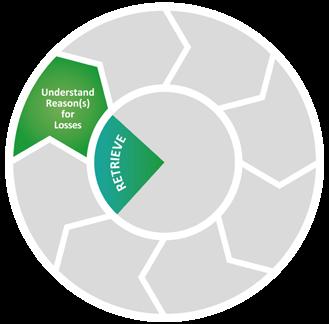
Understanding REAL reasons for losses
Freemasons who resign from a Lodge are often reluctant to disclose to members of the same Lodge the full reasons why they did so. However, understanding the reasons for resignation is essential for those of us managing membership.
1. Because unless we understand why one member really resigned, we are unlikely to be able to correct the issue and retain his membership.
2. Because without knowing why people resign from a particular Lodge, we are unlikely to be able to prevent the issue recurring in future. Therefore, understanding the real reasons members resign helps us to correct issues and prevent them from happening again.
It is likely as a Lodge you may wish to seek the assistance from your Provincial / Metropolitan team when seeking to understand the REAL reasons for losses, this will be key to helping you establish any lessons that can be learnt.
Lessons learnt from losses
Hindsight gives us a chance to learn by what has happened. Understanding why Brethren may have left the Lodge in the past, gives a chance to prevent similar patterns occurring in the future.
By identifying the reasons for losses (resignations, exclusions and cessations), actions can be taken to address the causes and find solutions.

Once again you may wish to seek the assistance from your Provincial / Metropolitan team when reviewing these lessons learnt, however they will prove vital in enabling members to better understand your lodge.

Please remember this guide is a printed summary of the Members’ Pathway –more details are available online and your Provincial Members’ Pathway Team are your first point of contact for guidance and support.
For more information please visit: b.ugle.org.uk/membership